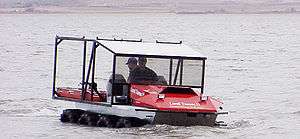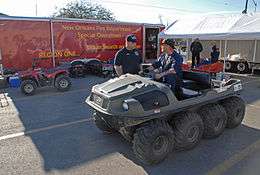Amphibious ATV

An amphibious all-terrain vehicle (AATV) is a small off-road, and typically six-wheel drive, amphibious vehicle. They were developed in the early 1960s and quickly became popular in both the US and Canada. These vehicles are now used by enthusiasts and professionals worldwide for recreation and industry.
These vehicles earned their own classification - all-terrain vehicle (ATV).[1] However, after the introduction of small three- and four-wheeled off-road motorcycles in the 1970s and 1980s, these have become better known as ATVs than the original amphibious ones.
History
(Amphibious) ATVs were made in the United States a decade before 3- and 4-wheeled ATV's were introduced by Honda and other Japanese manufacturers. After the presentation of the Jiger in 1961, numerous manufacturers offered a number of similar small off-road vehicles, that were designed to float and were capable of traversing swamps, ponds and streams as well as dry land. Because they were smaller and much simpler in construction than (amphibious) cars, they were much cheaper to produce and quickly gained considerable popularity. By 1970 there were almost 60 companies producing amphibious 6x6 vehicles. There was even a professional racing association dedicated to the 6x6, holding numerous competitions across the USA. These amphibious vehicles were originally called all-terrain vehicles - or ATVs.
In the early 1970s however there was a rapid decline in sales of this type of ATVs, forcing most manufacturers to cease production. Reasons were:
- the 1973 oil crisis prompted many North Americans to tighten their belts and spend less on recreational vehicles.
- the introduction of the 1970 Honda ATC90 threewheeler offered a fun alternative at some $600 / $800, when a 6x6 would cost $1,500.
- The simple construction of the original ATVs attracted many companies that were interested in making a quick buck, but underestimated the engineering needed, leading to poor quality products, that gave the industry a bad reputation.
- With most models utilizing 2-stroke engines, the 6x6's didn't run well unless properly maintained. 4-strokes were available, however, they were under-powered with at most 12 hp.
Only a small number of manufacturers of this type of vehicle remain today.
NATVA
NATVA (National All-Terrain Vehicle Association) was the official amphibious racing association and had its own magazine. "Races started around 1969, but I don't know when they finally ended. Most of the races were in the northeast and upper midwest. I have a NATVA magazine that shows regions covering the whole country, but as far as I can remember they never had a race schedule for all of them. Michigan, Wisconsin, Ohio, Indiana, Pennsylvania, New York, New Jersey, Maryland, and Virginia are the states I know for sure, but there are probably more.
There were four "National" events a year and regionals most every other weekend or so someplace in the country. Most of the teams that did really well owned dealerships or part of an ATV manufacturing company. They had the advantage of cheaper parts and direct tech knowledge from the source. In 1972 and 73 Scott Slonaker was probably the most dominant, then Larry Shorts, Larry Smith, the McKays (all Attex) and the Fischer Scrambler team out of Ashtabula, Ohio. There were an awful lot of competitive Max drivers, but the ones I remember were individuals and not part of a race team. I'm sure there are more that I'm forgetting, and others that took over in later years". The NATVA races were quite the events to attend, attracting thousands of spectators.
Characteristics
Although many differing variants have been developed over the years, and new ones are still being devised, most amphibious ATVs share most of the following characteristics. In contrast to today's ANSI definition of an ATV: "a vehicle that travels on low pressure tires, with a seat that is straddled by the (single) operator, and with handlebars for steering control", an AATV is intended for multiple riders, sitting inside, and will usually have two control sticks (and in some cases a steering wheel or joystick) rather than motorcycle-type handle bars as stipulated in the current definition. Typically constructed with a hard plastic or fiberglass watertight body"tub", AATVs usually have six or eight wheels - all driven - with low pressure (around 3 PSI) balloon tires, no suspension (other than what the tires offer) and no steering wheels. Directional control is accomplished through differential steering - just as on a tracked vehicle - either by braking the wheels on the side where you want to turn, or by applying more throttle to the wheels on the opposite side. Most contemporary designs use garden tractor type engines, that will provide roughly 25 mph (40 km/h) top speed. AATVs typically do not meet vehicle regulations in most countries, and are therefore strictly Off Highway Vehicles.
Though not as fast as a straddled ATV, the amphibious 6x6 and 8x8 can be operated with precision at slow speeds, carry more passengers and cargo, and of course, has the ability to float. Although the spinning action of the tires is enough to propel the vehicle through the water - albeit slowly - outboard motors can be added for extended water use. On land the combination of a large number of wide wheels and tires, low tire pressure and low vehicle weight, all result in exceptionally low ground pressure, high grip and off-road ability. Nevertheless, for further enhanced off-road, snow and mud performance, optional tracks can be mounted directly onto the wheels.
Vintage manufacturers and models
There were over 70 manufacturers of amphibious ATVs in the 1970s, here's a few popular manufacturers from that time period:
- The Jiger, the world's first to produce ATVs, starting in 1962
- The Amphicat, ca. 1965 - 1975
- The Terra Tiger by Allis-Chalmers Manufacturing Company, late 1960s & early 1970s
- The Penguin manufactured by Pengor, a Canadian company. Fiberglass body, four wheeled, rear engine, rear wheel drive.
- Attex produced several models from 1968–1983, some stood out due to their high 55 mph (89 km/h) top speed
- The Coot, that featured an articulated twin hull, kept all of its four wheels on the ground as much as possible, even when driving on very rough terrain. In production from 1967 - 1985.
- The Coot2, an updated Coot featuring hydraulic drive. http://coot2.com/coot2.php
- Starcraft, manufactured by the RV and boat company
- Sears Sportster, manufactured by the hardware store Sears
- Wedge, manufactured by Sperry-Rand, who actually produced the first 3-wheeler!
- Chapparel, who also manufactured many of the engines the amphibious atvs used
Current manufacturers and models


Although amphibious ATVs aren't widely known today, they can be found everywhere from a farm to the oil fields. Modern amphibs are used for industrial applications due to their capabilities that traditional off-road vehicles don't have. Other uses for these machines are recreation, such as trail riding or exploration.
Current brands of these machines include:
- SHERP ATV is an amphibious ATV made in Russia and Ukraine and assembled in Canada. Current models: SHERP PRO KUNG 4X4 and SHERP PRO PICKUP 4X4
- Lite Technologies, manufacturer of hydraulically driven 8x8 and tracked AATV [2]
- ZZGT, manufacturer of tracked AATVs in Russia (models crawler transporter: ZZ-3, ZZ-4, ZZ-5, ZZ-25, ZZ-28)
- ARGO, manufacturer of 6x6 and 8x8 models
- HydroTraxx, fully hydraulic drive 6x6
- Land Tamer, steel or aluminium hull heavy duty 6x6 or 8x8
- MAX, producing several 6x6 models (now owned by Mxi, but seems to be out of business, parts available at 6x6parts.com)
- Gibbs Technologies manufactures the Quadski,[3] which utilizes the BMW K1300 engine[4] (1293cc inline-4, 175 HP), and reaches speeds of 45 mph on land and over the water (water performance similar to that of personal water craft [PWC] such as JetSkis, WaveRunners, & SeaDoos).
- Terra Jet, manufacturer of 4X4 and 6X6 sport and utility models featuring front wheel steering
- XIBEIHU, manufacturer of Amphibious vehicle.
- WildPanther, manufacturer of Amphibious vehicle.
- Mudd-Ox, manufacturer of hydraulically driven 8x8 Amphibious vehicles
References
External links
- FAQ page,
- amphibiousvehicle.net, includes information on many known AATVs.
- Terra Jet
- ZZGT, information about Russian producer of tracked AATVs.
- 6x6world, information about all amphibious AATV's including vintage and modern.
- [http://www.6x6talk.com, Up to date discussion board concerning AATV's.